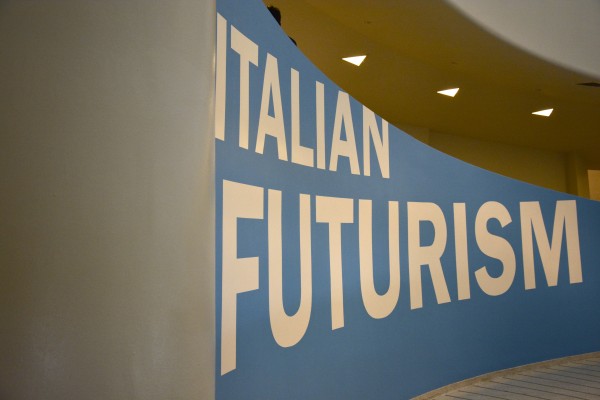New York is All About Italian Futurism
March 2, 2014

It is the first time that an exhibition this complete on futurism, knoqn as “Italian Futurism, 1909-1944: Reconstructing the Universe,” has been displayed in the United States. With about 400 pieces by 80 artists, this exhibit, which opened at the Solomon R. Guggenheim Museum on Feb. 21, has already achieved global success.
“A project of this level has been only brought to Italy,” Vivien Greene, senior curator of the Guggenheim explained. Greene specializes in the arts of 19th and early 20th centuries and Italian Modernism.
Futurism has been crucial for the development of art. Initially born as a literary movement by Filippo Tommaso Marinetti, a well-known Italian poet and editor, the movement meant to bring art “to the next level,” away from the traditionalities that came before. Indeed, Futurism served as a young wave in art, which led to the development of modernism.
Inspired by the innovations of the time, such as the industrial city, the machines and the discovery of aviation, to which a whole section is dedicated, “Futurism exalted dynamism, the new and the disruptive,” Greene said on Thursday, Feb. 20, at the press conference for the exhibit. Together with these impulses for innovation, the movement also wanted to give Italy back its honor, at the time, was impotent and which was a divided country.
The artistic current has been praised as much as it has been criticized. With the start of World War I, Marinetti became particularly interested in Benito Mussolini’s ideologies and became his follower. Marinetti believed that the war had a deep aesthetic beauty and that, it “would have brought Italy’s land possessions back to Italy,” as Greene and her team explained on the wall captions in the museum.
“This is a very ambitious exhibition,” Richard Armstrong, director of the Guggenheim said on Thursday. The exhibit features both the heavy message of Fascism, as well as different mediums of art expression. This is because of both the heavy message of Fascism but also because it features all different art media.
If painting is not “your thing,” then you have the opportunity to analyze theater projects by Fortunato De Perro and Giacomo Balla, which were incredibly innovative. They saw the elimination of the role of the actors and played on a bond between the artist and the audience and a fascinating game of colorful lights. To these, a whole separate gallery is dedicated. The exhibition not only features paintings or theatrical projects, but also sculptures, poetry, films, historical documents, photography, clothing, music scripts and objects such as the colorful ceramics plates by Bruno Munari and Torido Mazzotti and advertisements. “We tried to integrate all of these different language of arts as you walk through the spiral,” Greene said.
Advertisements? Yes, Futurism anticipated what, in America, exploded with the names of Pop Art and Andy Warhol. “Italian Futurism, 1909-1944: Reconstructing the Universe” features posters of the Italian Campari Bitter, by the artist Fortunato Depero. A whole exhibition on Depero, who saw his artistic life between the current of Futurism and Modernism, also recently opened on Saturday Feb. 22 at The Center for Italian Modern Art (CIMA). With the opening of this exhibit, CIMA celebrates its first opening.
“Italian Futurism, 1909-1944: Reconstructing the Universe” follows a chronological path. From the first “Manifesto of Futurism,” by Marinetti, to its developments through cubism, avant-garde poetry and film, to the Heroic period characterized by paintings that reach abstractism, and until the modern era.
Following the rotunda of the museum, on the first floor, there is an incredibly well-intact first publication on the “Manifesto” in the French periodical Le Figaro, published in 1909. In the last level, “murals” by Benedetta, Marinetti’s wife, are featured. “The two didn’t use the same name so that she could have success in her own right,” Greene said. “These murals came to us from the Poste Italiane of Palermo (Italian Post Office of Palermo). “They had never left that office,” Greene said, empathizing the important role that women had in the movement.
“The exhibition underlines paradox, a great motif of the show, and one, of course, is that while we all relate futurism with Fascism, Mussolini di not want Futurism to be art of the state, so it sounds confusing, but it is part of the story,” Greene said. “Another great motif of the show is the idea of the total work of art. This integration of all these languages of art contributes to the idea of dynamism of futurism”, which goes extremely well with the spiral architecture of the museum, designed by Frank Lloyd Wright. In fact, “the subtitle of the exhibition, ‘Reconstructing the Future’ goes back to this idea of making everything Futurist and takes its name from a manifest by Balla and De Perro, called ‘Ricostruzione futurista dell’universo,’” Greene concluded.
“Italian Futurism, 1909-1944: Reconstructing the Universe” opened to the public on Friday, Feb. 21 and run through until Sep 1.









